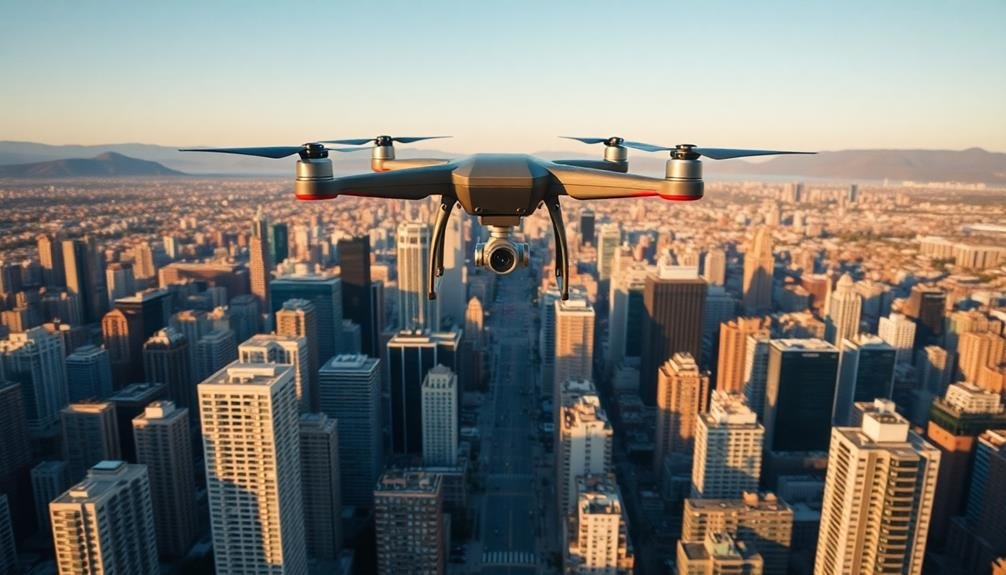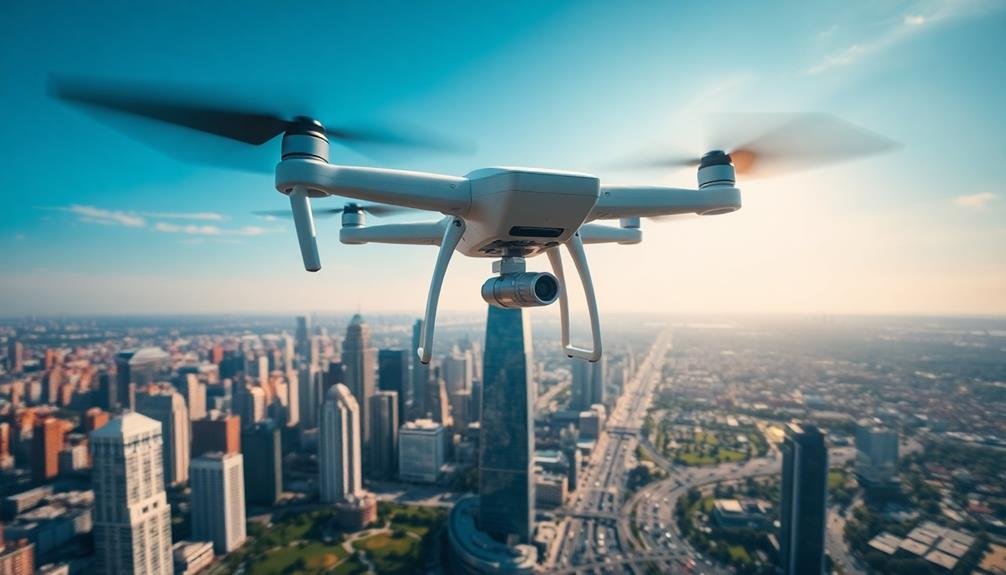To capture stunning aerial dolly zoom drone shots, start by mastering your flight control for smooth movements and steady altitude. Choose the right focal length; wide-angle lenses create exaggerated effects, while longer focal lengths offer subtler results. Plan your subject and background carefully, ensuring enough space between them for an effective dolly zoom. Adjust your speed and altitude consistently, flying away from the subject while increasing altitude (or vice versa for a reverse effect). Finally, enhance your footage in post-processing with stabilization, color grading, and subtle motion blur. These tips will elevate your aerial cinematography, but there's always more to explore in the world of drone videography.
Key Takeaways
- Master smooth drone control, practicing precise movements and maintaining steady altitude during flight.
- Choose appropriate focal lengths: wide for dramatic effects, medium for balance, long for subtlety.
- Plan subject and background carefully, ensuring adequate space and strong visual elements for impact.
- Maintain consistent speed and adjust altitude smoothly while flying towards or away from the subject.
- Enhance footage in post-processing with stabilization, color grading, and subtle motion effects for polished results.
Master Drone Flight Control

To execute aerial dolly zoom shots, you'll need to master precise drone flight control. Start by practicing smooth, controlled movements in all directions. Focus on maintaining a steady altitude while moving forward, backward, left, and right. Develop muscle memory for subtle joystick adjustments to achieve fluid motion.
Next, work on perfecting your hover skills. A stable hover is vital for initiating and ending dolly zoom shots. Practice keeping your drone perfectly still in various wind conditions. Use visual references and your drone's telemetry data to maintain position.
Master the art of flying at consistent speeds. You'll need to move your drone at a steady pace while simultaneously adjusting the zoom. Practice flying at different speeds, from slow creeps to faster movements, always maintaining smoothness.
Learn to fly in straight lines and perfect arcs. These flight paths are important for classic dolly zoom effects. Use your drone's onboard grid or reference points in the landscape to keep your trajectory true.
Choose the Right Focal Length

When selecting focal lengths for aerial dolly zoom shots, understanding the impact of different lens options is essential. For drones, you'll typically work with wide-angle lenses, but the specific focal length can dramatically affect your dolly zoom effect.
Wider focal lengths, like 16mm or 24mm, create a more exaggerated dolly zoom effect. They're ideal when you want to emphasize the distortion and create a dramatic reveal or sense of unease. These lenses work well for landscapes or cityscapes where you're showcasing a vast area.
Medium focal lengths, around 35mm to 50mm, offer a more balanced dolly zoom effect. They're versatile and can be used for various subjects, from architecture to natural scenes. These focal lengths provide a noticeable effect without being too extreme.
Longer focal lengths, such as 70mm or 85mm, produce a subtler dolly zoom effect. They're excellent for isolating subjects or creating a more compressed perspective. Use these when you want a more refined, less dizzying effect.
Plan Your Subject and Background

The success of your aerial dolly zoom shot hinges on careful planning of your subject and background. Choose a subject that's visually interesting and can remain stationary throughout the shot. It's essential to select a background that offers depth and contrast, enhancing the illusion of movement created by the dolly zoom effect.
Consider the following elements when planning your shot:
- Distance: Confirm there's enough space between your subject and background for the effect to work effectively.
- Composition: Frame your subject in a way that allows for dramatic reveal or concealment of background elements.
- Lighting: Take advantage of natural light or plan for ideal lighting conditions to enhance the visual impact.
Scout your location beforehand to identify potential obstacles or limitations. Look for backgrounds with strong linear elements, such as roads, bridges, or buildings, which can accentuate the warping effect of the dolly zoom.
Be mindful of wind conditions, as they can affect your drone's stability during the shot. Practice your flight path and timing to achieve smooth, consistent movement.
Adjust Speed and Altitude

With the subject and background in place, mastering speed and altitude adjustments becomes essential for executing a flawless aerial dolly zoom. You'll need to simultaneously adjust your drone's speed and altitude while zooming in or out with your camera.
Start by flying your drone away from the subject at a consistent speed, gradually increasing altitude. As you do this, zoom in on your subject to maintain its size in the frame.
For a reverse dolly zoom effect, fly towards your subject while decreasing altitude and zooming out. The key is to maintain a smooth, steady movement throughout the shot.
Practice adjusting your drone's speed and altitude controls precisely, as even small inconsistencies can ruin the effect. Experiment with different speeds to find what works best for your scene.
Slower movements often create a more subtle, eerie effect, while faster speeds can produce a more dramatic, disorienting result. Remember to factor in wind conditions, as they can affect your drone's stability and speed.
Always monitor your drone's battery life and verify you have enough power to complete the shot safely. With practice, you'll develop a feel for the perfect balance of speed, altitude, and zoom to create stunning aerial dolly zoom shots.
Post-Processing for Enhanced Effect

Having captured your aerial dolly zoom footage, post-processing can greatly enhance the final effect. Start by stabilizing your footage to smooth out any unwanted camera movements. Use your video editing software's built-in stabilization tools or third-party plugins for best results.
Next, adjust the color grading to create a consistent look throughout the shot. This can help emphasize the dolly zoom effect by ensuring viewers focus on the movement rather than color inconsistencies.
Consider adding subtle motion blur to accentuate the sense of movement. This can be achieved through your editing software's blur effects or by adjusting shutter speed in post. You may also want to experiment with speed ramping, gradually increasing or decreasing the playback speed to heighten the dramatic impact of the dolly zoom.
To further enhance your aerial dolly zoom shots, try incorporating these elements:
- Audio effects, such as whoosh sounds or musical crescendos
- Subtle vignettes to draw attention to the center of the frame
- Text overlays or graphics that react to the zoom effect
Frequently Asked Questions
What Equipment Is Needed for Aerial Dolly Zoom Shots Besides a Drone?
You'll need a drone with a camera capable of zooming. Don't forget a remote controller with a screen or smartphone mount. A gimbal's essential for smooth shots. Finally, get extra batteries and memory cards.
How Do Weather Conditions Affect the Success of Dolly Zoom Drone Shots?
You'll find that wind and rain are your biggest enemies for dolly zoom drone shots. They'll affect stability and visibility. Bright sunlight can cause overexposure, while low light impacts image quality. Choose calm, clear days for best results.
Are There Legal Restrictions for Capturing Aerial Dolly Zoom Shots in Certain Areas?
Yes, there are legal restrictions for aerial shots in many areas. You'll need to check local drone laws, no-fly zones, and privacy regulations. Don't forget to obtain necessary permits before flying your drone for dolly zoom shots.
Can Dolly Zoom Effects Be Achieved With Entry-Level or Budget Drones?
You can achieve dolly zoom effects with budget drones, but it'll be challenging. You'll need to manually adjust zoom while flying, which requires skill. Higher-end drones with built-in zoom features make it easier and smoother.
How Long Does It Typically Take to Master the Aerial Dolly Zoom Technique?
It'll take you several weeks to master aerial dolly zoom. You'll need to practice consistently, understand your drone's capabilities, and fine-tune your coordination. Don't get discouraged; with dedication, you'll see improvement in your shots.
In Summary
You've now got the tools to create breathtaking aerial dolly zoom shots with your drone. Remember, practice makes perfect. Keep honing your flight control, experimenting with focal lengths, and refining your subject choices. Don't forget to play with speed and altitude for varied effects. Finally, polish your footage in post-processing to truly make it shine. With these tips, you'll be capturing mind-bending drone shots that'll leave your audience in awe. Get out there and start creating!

As educators and advocates for responsible drone use, we’re committed to sharing our knowledge and expertise with aspiring aerial photographers.




Leave a Reply